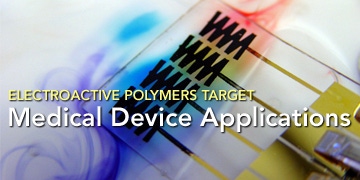Electroactive Polymers Target Medical Device Applications
April 16, 2009

An Irish company is actively investigating potentialapplications in medical devices for a novel conductive polymer that changesvolume and other properties in response to an electrical stimulus.
Potential applications include:
minimally invasive devices with enhancedmaneuverability, such as guidewires, catheters and leads,
delivery and retrieval devices, such as emboliccoils used for implant detachment,
microsurgical tools for ophthalmic surgery,neurosurgery or fetal surgery, and
conducting polymer coatings forneurostimulation.
"In terms of commercial applications of Micromuscle, thereare currently no FDA-approved devices incorporating the technology, but thereare a number of applications currently being researched," says Maura Leahy,marketing manager for Creganna,a medical device development company based in Galway, Ireland.
The underlying technology is based on electroactive polymersdeveloped by the University of Linköping in Sweden. The polymers swell andcontract as ions and water enter the polymer when a small voltage (typically1-2V) is applied. When the voltage is removed or reversed, the polymercontracts and resumes its original shape.
The bulk volume change of the polymer forms a swelling"volumetric" actuator, in one of the potential uses. In someinstances, the polymer may be attached to a metal. An electric current wouldcause the entire structure to bend.
Creganna recently acquired the patents for the technologyfrom Micromuscle AB of Sweden after the withdrawal of a venture capitalistforced the Swedish company to seek voluntary liquidation.
Micromuscle was founded in 2000 as a spin-off from leadingresearch on conducting polymers at Linköping University. The mainshareholders of Micromuscle were Industrifonden, CIMON Medical and IteksaVenture.
One of the key patents for the technology, "Microtools", was granted by the U.S. Patent Office on Feb. 19, 2008. The electroactivepolymers used by Micromuscle are from the group consisting of pyrrole, aniline,thiophene, para-phenylene, vinylene and phenylene polymer. The discovery of electricallyconductive polymers was awarded the Nobel Prize in 2000. Micromuscle is describedas the most advanced application of the technology for the medical devicearena, particularly for minimally invasive therapies.

Electroactive Polymers Target Medical Device Applications
About the Author(s)
You May Also Like





